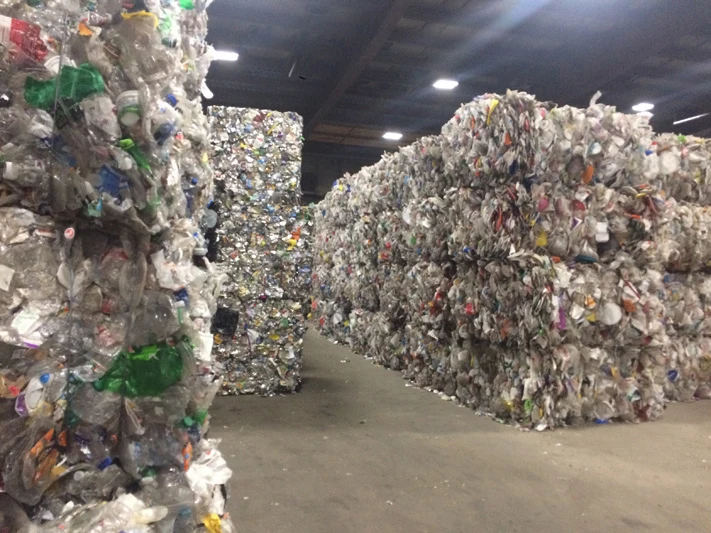
Recycling Today archives
To determine the best way to recycle and reuse plastic, researchers at the U.S. Department of Energy’s (DOE) National Renewable Energy Laboratory (NREL) examined the benefits and trade-offs of current and emerging technologies.
The paper, “Technical, economic and environmental comparison of closed-loop recycling technologies for common plastics," provides a comparison of various technologies for closed-loop recycling. This allows for the reuse of plastic through mechanical or chemical processing, eliminating the need for fossil-fuel-derived virgin materials. It considered technical metrics, such as material quality and retention, and environmental metrics, including energy use and greenhouse gas emissions.
“We know cost is one of the primary ... drivers for recycling for companies wanting to invest in it,” says Taylor Uekert, the lead author. “I think it’s just so important to remember that there are other things that are equally important for our life on this planet, and we need to be considering those environmental impacts as well.”
Her co-authors, all from NREL, are Avantika Singh, Jason DesVeaux, Tapajyoti Ghosh, Arpit Bhatt, Geetanjali Yadav, Shaik Afzal, Julien Walzberg, Katrina Knauer, Scott Nicholson, Gregg Beckham and Alberta Carpenter.
The paper outlines how effectively closed-loop recycling technologies would work on polyethylene terephthalate (PET) and three types of polyolefins: high-density polyethylene (HDPE), low-density polyethylene (LDPE) and polypropylene (PP). The recycling rates of these polymers varied in the United States from 2 percent for LDPE to 15 percent for PET bottles and containers in 2019, the authors say.
Two closed-loop recycling methods are available for HDPE, LDPE and PP plastics. There is mechanical, in which the plastic is grounded, melted and made into something new. There also is a solvent-based dissolution, which removes impurities so that the plastic is of suitable quality for reuse. Those same processes can be used on PET in addition to enzymatic hydrolysis, glycolysis and methanolysis.
More than 400 million metric tons of plastic waste are generated globally annually. Current recycling strategies can capture a fraction of these plastics, but there is a lack of consistent data on the capabilities and impacts of these processes, according to the authors. The NREL study quantitatively characterized the performance of plastic recycling technologies—including factors that are usually only discussed qualitatively, such as contamination tolerance, and established a methodology for comparing new recycling processes as they emerge.
Although mechanical recycling outperforms all other technologies and virgin plastic production across economic and environmental metrics, the process yields lower-quality plastic. Increasing the quality and quantity of plastics to be recycled through better sorting and pretreatment could improve the viability of mechanical recycling, according to the researchers.
“To enable a circular system where we keep as much material in the economy as possible, that's when we need to improve our [material] retention through things like better sorting and better yields of your recycling processes,” Uekert says. “If you have a process that only has a 75 percent yield, you're going to end up needing slightly more electricity, slightly more chemicals, to recycle one kilogram of plastic than you would if you had something like a 90 percent or higher yield. That means your overall environmental impacts, your overall cost, is going to decrease as you increase your material retention.”
The researchers point out that recycling should be treated as a decarbonization opportunity, with the technologies using electricity that could be generated from renewable sources.
Funding came from the U.S. Department of Energy’s Bioenergy Technologies Office and Advanced Materials and Manufacturing Technologies Office as part of the BOTTLE Consortium, a collaborative effort that stands for Bio-optimized Technologies to keep Thermoplastics out of Landfills and the Environment. NREL is the U.S. Department of Energy's primary national laboratory for renewable energy and energy efficiency research and development. NREL is operated for DOE by the Alliance for Sustainable Energy LLC.
Latest from Recycling Today
- Ecore receives investment from low-carbon fund
- Chinese policy moves affect nonferrous markets
- Machine learning researched as battery fire detection technique
- ResponsibleSteel says global decarbonization effort needed
- Carolina Metals Group, Spartan Recycling Group to merge
- UK government backs ReCircAl project to produce aluminum extrusion billet from scrap
- Magaldi Group announces dry ash management system
- Amp to operate Waste Connections MRF in Colorado





